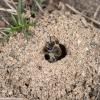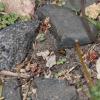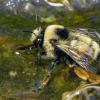Unsold pesticide-treated seed corn is used for ethanol production, resulting in pollution that puts people and pollinators at risk, and raising questions about disposal practices across the seed industry.
Researchers at the University of Nebraska–Lincoln noticed honey bees at one of their research sites were dying at an alarming rate, while hives at other locations seemed healthy. They then learned that local residents were reporting mysterious odors and strange illnesses in people, pets, and wildlife. Had there been a spill of industrial chemicals? Was there some other poison causing the problems?
The scale of the bee kills that the researchers observed suggested a major contamination of the landscape, so they began looking for a source. Pesticide testing results from a research project came back with astronomically high levels in milkweed plants. Higher levels of pesticides in milkweed close to a creek—100 times higher than found in plants further away—led them to ask questions about potential contaminants in waterways. Eventually, this led to a tip about a nearby ethanol plant that was reportedly using pesticide-treated seed to make ethanol, resulting in byproducts that were contaminating the community.

After honey bees in a university apiary died for no apparent reason, scientists discovered that milkweed plants in the locality were contaminated with extremely high levels of insecticides. Plants growing beside a creek had levels 100 times higher than other plants, leading the researchers to the source of the contamination, an ethanol biofuel plant. (Photo: Emily May.)
It turns out that the bee kills were connected to systemic pesticide pollution, especially neonicotinoid insecticides—neonics. These are the same pesticides that are linked to honey bee losses across the United States and the decline of native invertebrate species around the world. Neonics are commonly applied to many seeds before they are planted. Corn is the major crop used for ethanol production in the United States, and the vast majority of seed corn is coated with neonicotinoids and other pesticides. This is a major environmental problem in itself as contamination from planted seed impacts wildlife in and around crop fields. Despite their widespread use, we still lack critical information on how and where pesticide-treated seeds are planted.
While planting of treated seed is a known environmental issue, however, the risks associated with handling and disposal of leftover treated seed are only now coming to light. Millions of pounds of treated seed are left unplanted each year. This cannot be sold to farmers for future use because seed germination rates go down over time. Instead, the seed is given to the ethanol plant for processing into biofuel. This may seem like a win-win for the businesses—cheap disposal for the seed company and free raw material for the ethanol plant—but it is a huge loss for the environment and local communities. The pesticide residues on the seeds remain in the solid and wastewater byproducts of ethanol production, making them extremely toxic.

The majority of seed corn planted in the United States is coated with insecticides. Unsold seed corn is given to an ethanol plant for processing into biofuel—cheap disposal for the seed company and free raw material for the ethanol plant. But because this toxic material is not regulated as a pesticide, it has a significant impact on the environment and local communities. (Photo: USDA-NRCS/Lance Cheung.)
The crux of this situation is that although treated seed is coated with a toxic mix of insecticides and fungicides, these seeds are not regulated as pesticides—and thus, there is little oversight on how the plant handles and disposes of treated corn seed and contaminated byproducts.
Beyond processing treated seeds, the ethanol plant has failed to maintain basic protections to limit off-site contamination, and has even sold and applied contaminated byproducts to local farms as fertilizers and soil conditioners. Wastewater in the plant’s lagoons is contaminated with clothianidin (a highly toxic neonic) at levels up to 5,000 times above the EPA’s acute freshwater invertebrate benchmark. (A recent article in The Guardian gives more information on neonic levels measured in waste stored at the plant.) This wastewater can be discharged into local streams, likely resulting in the high levels of clothianidin measured in milkweed growing near a creek. The plant’s lagoons are also poorly maintained, leading the state to require them to install groundwater monitoring wells this fall, but sampling results are not yet available. Pesticide contamination of the surrounding area has also occurred from the plant’s solid waste. Solid byproducts applied to fields contain clothianidin at levels up to 85 times the maximum application rate if it were clothianidin-treated seed being planted. This far exceeds levels that could kill a wide variety of species, including bees, butterflies, and aquatic invertebrates.
The plant continues to use treated seed to produce ethanol and has a growing stockpile of byproduct on site. Efforts by state regulators have so far failed to stop these troubling practices—in part because they are hamstrung by the fact that treated seeds are not considered pesticides. Even though pesticide regulations don’t apply, the contamination is severe enough to trigger other environmental violations. State regulators have issued numerous violations, yet the plant remains stubbornly out of compliance. According to assessments by state regulators, the plant’s byproducts contained at least 16 different pesticides at high levels. However, this is possibly an underestimate as the state only tested for a limited number of pesticides.
This contamination, and the state’s inability to halt it, raises the larger concern that current federal regulation fails to ensure the proper handling and disposal of pesticide-treated seed. The federal government exempts treated seed through the treated articles exemption, leaving regulators without clear oversight to prevent its mishandling. Given the absence of federal oversight, Xerces and our partners are working to address this loophole at the state level in the United States. Already, we have asked the state of California to regulate treated seed as pesticides. Other states should also consider greater oversight of pesticide-treated seed.
Xerces is working to bring attention to this issue and ensure that treated seed is disposed according to pesticide disposal regulations. This is critical in order to clean up this site and protect the community, and to avoid having other areas experience the severe contamination witnessed in Nebraska. Regulators and the seed industry must take action to ensure that excess seed does not lead to similar situations in other communities.
Further Reading
More information about neonicotinoids and their impacts
Xerces blog: Sowing Uncertainty: What We Do and Don’t Know about the Planting of Pesticide-Treated Seed
Read other articles about neonics on our blog
The Guardian (1/10/21): ‘There’s a red flag here’: how an ethanol plant is dangerously polluting a US village



